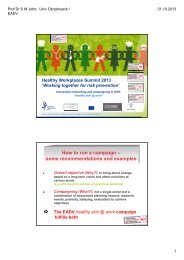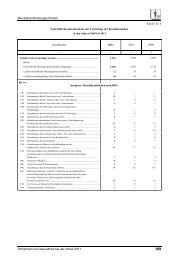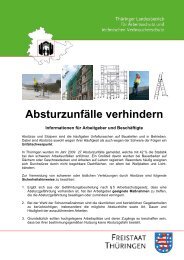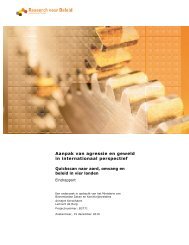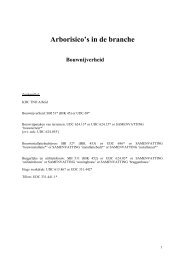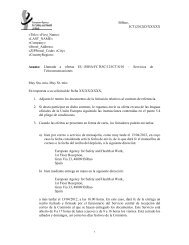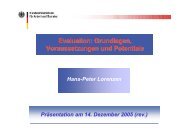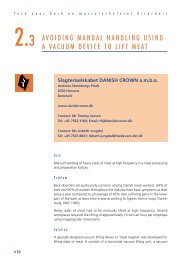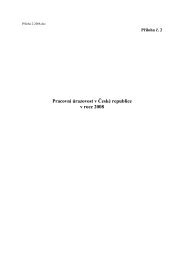ESENER-PSR 2009 - European Agency for Safety and Health at Work
ESENER-PSR 2009 - European Agency for Safety and Health at Work
ESENER-PSR 2009 - European Agency for Safety and Health at Work
You also want an ePaper? Increase the reach of your titles
YUMPU automatically turns print PDFs into web optimized ePapers that Google loves.
Step 3:<br />
Now, the selected addresses are screened in order to find out if they are single-site<br />
organis<strong>at</strong>ions or part of a multi-site unit:<br />
MM050 (=MM100 in countries without screener)<br />
May I first of all check: Is the establishment <strong>at</strong> this address a single independent company or<br />
organiz<strong>at</strong>ion with no further branch-offices, production units or sales units elsewhere in {country}?<br />
Or is it one of a number of establishments <strong>at</strong> different loc<strong>at</strong>ions in {country} belonging to the same<br />
company or organiz<strong>at</strong>ion?<br />
A single independent company or organiz<strong>at</strong>ion ...................................................... ( 1 ) go to MM102<br />
One of a number of different establishments .......................................................... ( 2 )<br />
## No answer .......................................................................................................... ( 3 ) go to MM102<br />
If the contacted address refers to a single-site company (answer-code (1)), the interview is<br />
immedi<strong>at</strong>ely filtered to MM102 ff., i.e. the main-interview then starts without any further<br />
differences to the st<strong>and</strong>ard-procedure.<br />
Step 4:<br />
Yet, in all multi-site enterprises the respondent is now asked <strong>for</strong> the number of employees<br />
working in the company in total, i.e. in all sites in the respective country (MM050a). This<br />
in<strong>for</strong>m<strong>at</strong>ion is needed <strong>for</strong> filtering out companies with actually less than 10 employees.<br />
Step 5:<br />
The next step is to ask the respondents about the number of establishments (including the<br />
headquarters) with 10 or more employees belonging to the company (MM051). If none of the<br />
company’s establishments surpasses this size-threshold or if the respondent refuses to<br />
answer this question, the screening is ended <strong>at</strong> this stage <strong>and</strong> the respective reason of nonresponse<br />
is entered.<br />
Wherever there is only one establishment within the required size-range (10+ employees), the<br />
interviewer asks <strong>for</strong> the name <strong>and</strong> address of the Human Resources manager within this<br />
establishment <strong>and</strong> enters this in<strong>for</strong>m<strong>at</strong>ion in the screen (MM053a). If the only establishment<br />
with 10 or more employees is the one the interviewer is already connected with, the questions<br />
of the main interview now immedi<strong>at</strong>ely follow (provided th<strong>at</strong> the respondent is already the<br />
responsible Human Resources manager <strong>and</strong> not e.g. somebody <strong>at</strong> the switchboard).<br />
Step 6:<br />
In all other cases, i.e. in all companies with several establishments larger than 9 employees,<br />
additionally a question about the distribution of these establishments among the defined sizeclasses<br />
is asked:<br />
37



